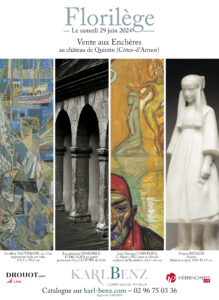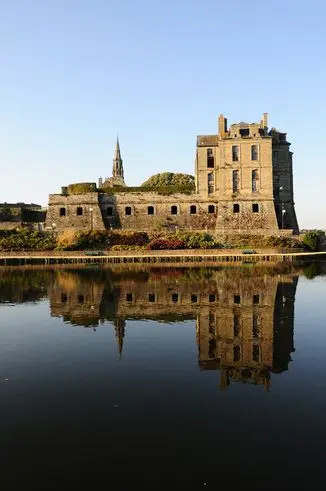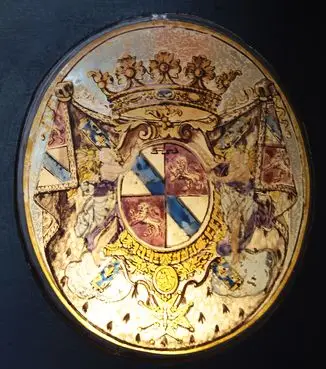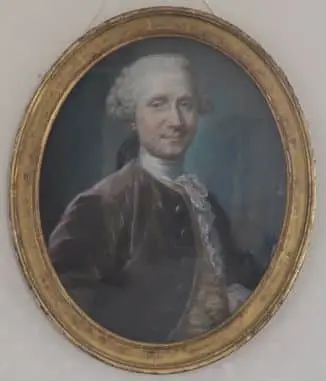

Between land, sky and sea… the Quintin’s demesne has the particularity of bringing together in the same park two castles, ramparts, an archive tower and formal gardens, in the heart of the Petite Cité de caractère of Quintin.
Preserved in the same lineage since the 12th century, the demesne of Quintin has seen many families: du Perrier, Rohan, Coligny, La Moussaye, Lorge, Choiseul, Polignac…
Mentioned in 1202, the “castellum novum”, the first castle of Quintin to be known by texts, seems to have been built in the second half of the 12th century by Alain de Penthièvre.
Geoffroy Ier Boterel, Count of Quintin will have a new fortress built: this “castrum novum”, mentioned in 1249, will give birth, to the west and at its feet, to an agglomeration, without enclosure and outside the enclosure of the fortress.
From the 14th century, it was called the “City of the New Castle of Quintin”, which shows both its origin and its dependence. The profession of arms and the part they took in the affairs of Brittany left the Boterels little time to stay in the “new castle”, an uncomfortable fortress whose role, with its garrison, was to protect the town that was developing at its feet.
It was probably at the time of the War of Succession (14th century) that the Boterels had a wall and moat built to protect the town, which also allowed them to better hold the region.
Four gates closed the access: to the north the Rose Gate, to the south the Saint-Julien Gate, to the east the Porte-Neuve, to the west the Grande Porte. In the 15th century, Quintin returned by marriage and extinction of the Boterel aux du Perrier – among whom Tristan du Perrier, first banneret of Brittany, faithful servant of Duke Peter II, and husband of Isabeau de Montauban, first cousin of Isabeau of Bavaria, Queen of France.
In 1451, the land of Quintin became a barony, the 9th of the Duchy of Brittany. In 1472, Quintin became possession of the House of Laval through the marriage of Jeanne du Perrier to Jean de Laval, son of Guy XIV and Isabeau of Brittany.
Rieux, Coligny and La Trémoille families succeeded each other there in the 16th century. It is with the Coligny family that Quintin knows his first protestant lords. At the end of the XVIth c., during the League wars, Quintin and the Castle are ravaged by the Duke of Mercoeur.
In 1605, Henri Duc de La Trémoïlle inherited a ruined castle and a devastated town. In 1633, he decided to sell it to his brother-in-law, the Marquis de La Moussaye (Marie de la Tour d’Auvergne, Henri de La Tremoille wife’s, was Henriette de la Tour d’Auvergne sister’s, Marquise de la Moussaye, and Henri de la Tour d’Auvergne, Marshal of Turenne).
This acquisition was difficult and disputed because the La Moussaye were fervent Protestants. They had to accept, in 1640, very harsh conditions: they were not to carry out any construction, not to reside more than fifteen days in a row in Quintin and only four times a year, not to establish any exercise of the so-called reformed religion and not to proselytize.
The Marquis de La Moussaye obtained from Anne of Austria in 1643, the authorization to build a castle and to make Quintin their main residence, but did not manage to remove the obligations related to religion.
He began in 1639, the demolition of all the elements of the old castle and in 1643, the construction of the new castle on the model of that of La Moussaye in Plénée-Jugon. At the same time, were built stables, with accommodation upstairs, (this will be the basis of the third castle, that of the eighteenth century).
The architect is Gabriel Androuet du Cerceau, most certainly from the famous family of architects. Thanks to the project of Eslevation de la vue du chasteau de Quintin (western façade that was not built), to the Vue du Château de Quintin at the beginning of the XVIIIth c. (Manuscrit du Président de Robien), the 1774 Plan and the remaining buildings to the south and east, completed by the foundations to the north of a pavilion, it is possible to reconstruct the entire 17th century castle, and to have a precise idea of its architecture. Situated on a terrace at the end of the promontory overlooking the pond and the road, the castle with its closed courtyard and its imposing walls now has only two sides, to the east and south, out of the four that it must have had; at their junction they have a double and imposing pavilion.
The appearance of the six-storey building, with bosses and separate roofs, is perfectly preserved in its present remains. Of a quite exceptional quality but unfortunately unfinished, the château de Quintin was, at the time, to be the first and largest classical castle in Brittany.
Many causes prevented the completion of the building: the high cost of the work (200,000 pounds in a few years), the fear by the Church and by the King that the castle would be used to make the Protestant faith alive and active, the many trials lost by the La Moussaye family and their impoverishment.
Initially slowed down or suspended, the work will stop definitively in 1666, partly with the affair of the bellows. Indeed, Mgr Denis de La Barde, bishop of Saint-Brieuc, had asked for their arrest by order of the King; in a movement of anger at the difficulties the bishop was raising, the Marquise de La Moussaye had raised her hand to strike him .
The La Moussaye were the only lords of Quintin to have made this city their permanent home for nearly forty years. Their son Henri de La Moussaye had no interest in Quintin, and sold the Château and the seigneury in 1681 to his cousin, Guy-Aldonce de Durfort, Marshal de Lorge, for 400,000 pounds.

Turenne’s favourite nephew, Guy-Aldonce de Durfort, Knight of the King’s Orders, Captain of the Bodyguards, Governor of Lorraine, Marshal of France, had covered himself with glory in Holland and saved Alsace.
In 1691, he obtained to have the land of Quintin erected as a duchy and from then on, he took the names of Duke of Quintin, Marshal of Lorge or Marshal-Duke of Lorge. He had two daughters: the eldest, “Mademoiselle de Lorge”, married the famous Duke of Saint-Simon in 1696, and the youngest, “Mademoiselle de Quintin”, became the wife of the famous Duke of Lauzun, aged sixty-three, at the age of fifteen.
Both will have their “stool” in Versailles. Her only son, Guy-Nicolas de Durfort, inherited Quintin in 1702.
He will first obtain from Louis XV to change the name of the duchy and to replace that of Quintin by Lorge, the inhabitants of Quintin preferring to keep the name of their former barony. Thus, in 1706 the name Lorge will be substituted to that of Couëtrach, in the parish of L’Hermitage and the duchy will become the duchy of Lorge.
The Duke undertook to transform the old stables and outbuildings at Quintin by erecting a pavilion at each end containing a circular staircase, which constitutes the present 18th century Château.
Pending the completion of this work, the Duke did not completely abandon the possibility of short stays in the 17th century castle and fitted out a few rooms for himself and his staff.
However, when they came to Brittany, the Durfort would first stay in their castle at Lorge, which they had partly built using ashlar stones recovered from the two wings under construction and from the unused ones of the 17th century castle.
The Château de Quintin was abandoned and its permanent inhabitants were only the intendant and the seigneurial officers.

His eldest granddaughter, Guyonne Philippine de Durfort and her husband Renaud César de Choiseul-Praslin became the owners of the seigneury in 1775.
From 1785 to 1790, they carried out major works in the 18th century Château under the direction of the architect Binet (ground floor, bedrooms and lounges, and installation of the dining room and a kitchen at right angles to the remarkable vegetable garden, the only one of this size in the region).
A great liberal lord nourished by The Encyclopaedia, the Viscount de Choiseul, who became Duke of Praslin in 1785, did not fear the Revolution and died in Paris in 1791, without having left France.
His wife had to face both the difficulties of the succession, and that of the revolutionary state, before which she showed cunning and courage. She thus succeeded in keeping the castle of Vaux-Le-Vicomte, then Vaux Praslin, and prevented the mayor of Quintin from having the castle and its lands sold as national property.
She had all the paintings painted in red and when times became better, she had them cleaned, thus allowing the conservation of the entire heritage.
During the Revolution, the old castle was used as a prison where the conditions of detention were very harsh, as the building was unhealthy and the windows were nailed shut. Saltpetre was made in the damp cellars.
On the death of the Duchess of Praslin in 1806, her youngest son, Count René de Choiseul, became the owner of the old seigneury. The suppression of feudal rights will radically change the relations between the successive owners of the castle, the town of Quintin, and its population.
The château de Quintin has indeed lost its quality of county capital, and its power, but it remains a residence that depending on the absence or presence of its owners fall asleep or live in the heart of the city.
The Marquise de Courtebourne later inherited it, and in 1876 she gave all the land needed to rebuild the Collegiate Church. She entered the Carmelite convent in Tournai on the death of her husband, became its superior in 1878, sold a large part of the castle’s furniture for the benefit of the convent and no longer returned to Quintin. Her heiress in 1905 was her first cousin Isabelle de Polignac, wife of Pierre-Adalbert Frotier de Bagneux, who had long been involved in the management of the marquise’s property.

It is their grandson, Jean de Bagneux, who inherited Quintin in 1935 and made it his main residence.
He undertakes a first renovation of the apartments, transforms the courtyard and creates a French garden on the east terrace, according to plans by the architect Moreux.
He was to be politically, socially, culturally and artistically active in the Côtes-du-Nord region: mayor of Quintin (1947-1983), senator of the Côtes-du-Nord (1959-1980), member of the General Council, of the Regional Council, president of the Cultural Affairs Commission of the High Assembly and of the Organising Committee of the Centre Beaubourg.
When he died in 1983, he left the château to his two sons, who kept it in joint ownership.
The eldest son, Count Gérard de Bagneux, opened the château to the public in 1986, thus avoiding its sale. Helped by his daughter Caroline, it was with duty and passion that he devoted all his time and energy to passing on the history of this heritage. He died in December 2016, Caroline surrounded by her children continues to manage the estate in the same spirit of respect, conservation and transmission.
Château & Domaine de Quintin
22 800 QUINTIN
+33 (0)2 96 74 94 79
info@chateaudequintin.fr
Legal Notice – Privacy Policy – Création site web par Elyazalée
Following the latest measures announced by the government, the Château de Quintin is exceptionally closed to visitors until further notice.